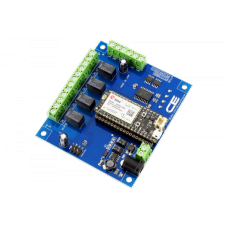4-Channel 1-Amp SPDT Signal Relay Shield + 4 GPIO with IoT Interface
This IoT 4-channel low-power signal relay controller is capable of hosting many types of IoT communication modules, including Particle Photon, Electron, Arduino, and more. On-board SPDT relays are ideally suited for low-power signal switching applications, up to 1 Amp at 12VDC. NCD SPDT relay controllers have three connection terminals for user-access to each relay. We use high-quality Omron relays with a low on-resistance between contacts. Designed primarily for resistive or mildly capacitive low-power signals, the on-board relays in this design focus on signal integrity, making it an ideal choice for telecommunications and low-power audio switching applications.
This controller is based on the MCP23008, a common I2C interface chip for GPIO applications. In this design, the GPIO port is used to control 4 on-board SPDT relays. Four programmable Digital Input/Output port pins are also available via screw terminals for use in Contact Closure detection applications or monitor and control external TTL circuits. Three on-board address jumpers allow up to 8 similar devices (based on the MCP23008 or MCP23017) to be chained to the same I2C bus for individual control. On-board status LEDs display the on/off status of each relay. This controller may be powered using our optional power supply or with 12VDC and direct screw terminal connection of bare power wires. Each relay is accessible to the user via screw terminals, capable of accepting 14 AWG wire.
IFTTT
Leverage the power of IFTTT.com and Particle services to do almost anything. Send a tweet if someone rings your doorbell, send a notification to your phone if someone opens a door, turn on almost anything right from your phone with simple setup, the possibilities are endless. NCD provides this controller with a pre-programmed Particle Photon module for easy connection to IFTTT. No programming required! Just use the simple IFTTT interface to setup your different configurations.
Powered By Particle
Give your Particle Photon the power to interact with the real world in ways never before possible. Complete with a Particle Photon module pre-flashed with our custom IFTTT firmware, NCD compatible shields allow for control of many types of relays, monitoring digital and analog sensors, and much much more. Chain I²C accessory boards to your system to add whatever you may need for your next control and automation project.
What is the NCD IoT Interface?
The NCD IoT Interface provides users with a means of changing or upgrading the IoT communications technology as new technologies emerge. The NCD IoT Interface is directly compatible with Particle Photon for WiFi communications, Electron for Cellular Communications, Bluz for Bluetooth. Optionally, adapters may be installed to provide a direct interface to Arduino Nano, Micro, USB, PyCom WyPy, Onion Omega, Raspberry Pi, and much more. The NCD IoT interface allows you to re-use your hardware so it never becomes obsolete! Based on I2C communications, the NCD IoT Interface uses only 2 GPIO lines of your microcontroller, freeing the rest of your CPU for other tasks.
Unlimited I2C Expansion
Based on our plug-and-play I2C interface standard, all NCD IoT devices are equipped with a I2C expansion port, making it easy to expand to a wide variety of sensors, current monitors, relay controllers, PWM controllers, and much more! We are always designing new expansions for our plug-and-play I2C framework. We are dedicated to building a product line of interconnected devices to simplify all forms of automation. Re-use or upgrade your hardware in seconds by selecting the modules that best fit your needs, and chaining them together using the included I2C expansion cables!
1-Amp SPDT Signal Relay
This controller uses a 1-Amp small signal relay, allowing control of low-power telecommunications signals up to 12VDC at 1 Amp. Ideal for audio, telecommunications, and very low power switching applications. This relay has a low On resistance. The 1-Amp signal relay is of the SPDT variety, which provides Common (C), Normally Open (NO), and Normally Closed (NC) connections. Common is connected to NC when the relay is off. Common disconnects from NC and connects to NO when the relay is activated. All connections are made via screw terminals, capable of accepting up to 16 AWG wire.
Features
- 4-Channel SPDT Telecommunications Relay Controller
- 4-Channel Programmable Digital Input/Output
- Compatible with Electron, Photon, Bluz, or RedBear
- ESP8266 and USB IoT Interface Modules are Also Available
- Adaptable to Onion, PyCom, Raspberry Pi, Arduino
- Switch Low-Power Signals up to 1 Amp at 12VDC or 120VAC
- MCP23008 I2C Controlled SPDT Low-Power Signal Relays
- World’s Most Expandable Controller with I2C Expansion Port
- Wireless Remote Operation with Key Fob Expansion Option
- Use the Arduino Wire Language to Control Relays using I2C Bus
- IFTTT Firmware Available for Internet Relay Control
- Example Libraries Available on GitHub
Enter the code in the box below:



